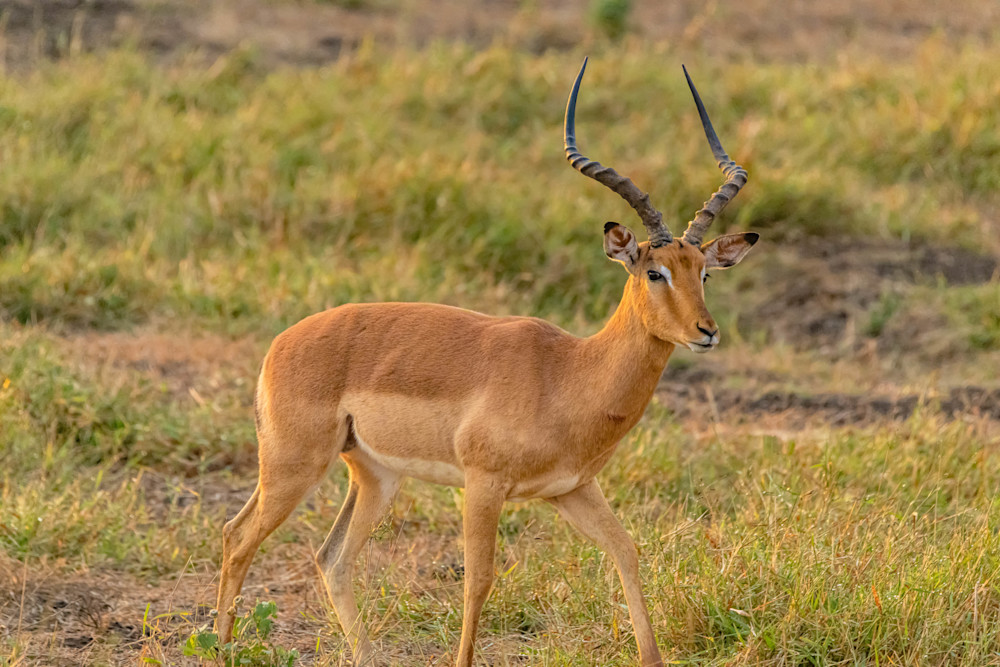In the expansive landscapes of Africa, the impala, with its elegant form and distinctive horns, becomes a graceful inhabitant of the wild. Here's a vivid portrayal of impala in their natural habitat:
**Savannah Ballet:**
On the sun-drenched savannah, a herd of impalas moves with an orchestrated grace, their sleek bodies resembling dancers in a natural ballet. The tall grasses sway in response to their passage, creating a rhythm that echoes the heartbeat of the wilderness.
**Golden Coats in the Sunlight:**
The impalas' coats, a lustrous blend of fawn and gold, catch the sunlight as they navigate the open plains. The play of light on their fur enhances the illusion of fluid motion, turning each impala into a living brushstroke in the canvas of the savannah.
**Elegance in Motion:**
With each stride, the impalas showcase an elegance in motion. Their slender legs carry them effortlessly across the terrain, and their bodies, adorned with a white underbelly and facial markings, create a striking contrast against the earthy backdrop.
**Graceful Horns and Leaping Antics:**
Male impalas, with their distinctive lyre-shaped horns, add an extra layer of visual drama. During the mating season, they may engage in impressive displays, leaping into the air with a series of graceful bounds—a spectacle that mirrors the exuberance of life on the savannah.
**Vigilance in the Herd:**
While grazing, impalas remain vigilant, their ears constantly swiveling to catch the slightest rustle. Their keen senses serve as a collective early warning system, ensuring the herd's safety from potential predators that may lurk in the shadows.
**Communal Grazing Grounds:**
The impalas form a mosaic of grazing patterns, creating communal feeding grounds where individuals share the bounties of the savannah. Their synchronized movements mirror the interconnectedness of life in the wild, where survival is a collective effort.
**Impala Nursery:**
In certain seasons, the savannah may witness the arrival of impala calves—a testament to the cycle of life. The nursery of young impalas, with their endearing awkwardness, adds a heartwarming touch to the scene, as they learn the intricacies of survival under the watchful eyes of the herd.
**Mirrored Reflections at Watering Holes:**
At watering holes, impalas gather to quench their thirst. The still water mirrors their forms, creating a serene tableau that reflects the unity of life in a shared oasis. The impalas' cautious sips are interwoven with the symphony of the surrounding ecosystem.
**Dappled Shadows in Acacia Groves:**
Among the acacia groves, impalas seek refuge from the heat of the day. The dappled sunlight filters through the branches, creating a play of shadows on their coats. The impalas' presence adds a timeless charm to the ancient landscape.
**Sudden Bounds and Escapes:**
In moments of perceived danger, impalas showcase their renowned agility. With sudden bounds and rapid acceleration, they can swiftly escape predators. The savannah becomes a theater of survival, where the impalas' evasive maneuvers underscore the delicate balance of predator and prey.
**Echoes of Alarm Calls:**
The impalas' communication is punctuated by alarm calls—a sharp, snorting sound that echoes across the plains. This vocal alert system serves as a collective response to potential threats, demonstrating the impalas' communal bonds and their innate understanding of the language of survival.
**Sunset Grazing:**
As the sun begins its descent, the impalas continue to graze, their silhouettes becoming part of the warm palette of the African sunset. The savannah, bathed in hues of orange and gold, becomes a living canvas where the impalas play their role in the eternal drama of life.
In the presence of impalas on the African savannah, the landscape comes alive with a symphony of motion, grace, and interconnectedness—a testament to the resilience and beauty of the wild.
















